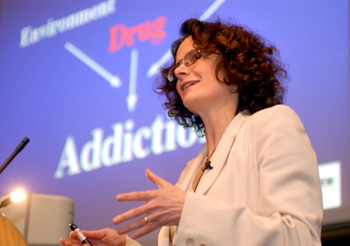
Dr. Nora Volkow delivered the 2003 Brain Awareness keynote address this week. Volkow, who will assume her duties as director of the National Institute on Drug Abuse next month, described research using brain imaging to understand the process of addiction. (photo by Dana Johnson)
Imaging reveals secrets of addiction: Brain Awareness keynote lecture
Brain images colored in vibrant blues, yellows and reds filled the screen at this week’s Brain Awareness keynote lecture. Dr. Nora Volkow, newly named director of the National Institute on Drug Abuse, riveted the capacity crowd in Light Hall with her fast-paced discussion of what happens in the brains of drug-addicted individuals.
Volkow, currently associate laboratory director for Life Sciences at Brookhaven National Laboratory, described highlights of her 20-year quest to understand the biochemical underpinnings of addiction. Volkow has relied on imaging technologies that offer a view of the living, working brain — particularly positron emission tomography (PET) — to probe the brains of drug abusers.
By using PET imaging to systematically measure proteins and brain activity in normal and drug-addicted individuals, her laboratory has narrowed in on the role that the neurotransmitter dopamine and the system of dopamine-using neurons play in the process of drug addiction. The dopamine system is known to be crucial to positive reinforcement, motivation, and drive, among other behaviors.
Volkow’s group chose one of the receptors for dopamine (the D2 receptor) for early studies in normal subjects and cocaine abusers. The brain images, colored along the rainbow spectrum to reflect relative receptor levels — violet is low, red is high — revealed regions of orange and red in normal users. The same regions were only yellow (lower concentrations of receptors) in cocaine abusers.
Images of brain activity in the same group of subjects also showed striking differences. Cocaine abusers had lower activities overall, mostly blue brain images, compared to strikingly yellow images from normal subjects.
When Volkow and colleagues looked for regions of overlap between low dopamine receptor expression and brain activity, they identified several areas in the frontal cortex — the front part of the brain that is associated with higher function.
“This was the first study that pointed to the frontal cortex as having a role in drug addiction,” Volkow said. “It was very surprising and intriguing that this higher level brain area was involved.”
It was known, Volkow said, that the frontal areas her group identified were implicated in obsessive-compulsive disorder. This signaled to the investigators that the frontal brain regions were likely involved in the obsessiveness of drug addiction, the inability of drug users to stop taking a drug, even when they consciously want to stop.
But did drug abuse cause low dopamine receptor levels in these areas, or did low dopamine receptor levels predispose individuals to drug abuse, Volkow wondered.
From their earlier studies, the investigators knew that there was wide variability in D2 receptor levels in normal subjects, some having levels as low as cocaine-addicted individuals.
“What does it mean to have low D2 receptor levels and not be addicted to drugs?” Volkow asked.
To address this question, the investigators measured D2 receptor levels in non-drug abusers, injected a single dose of the stimulant drug methylphenidate, and asked the subjects to describe how the drug made them feel. They found a significant difference in the levels of D2 receptors in individuals who reported the experience as pleasant vs. unpleasant. Subjects with low receptor levels found the drug pleasant; those with high levels found it unpleasant.
“The effects depend not just on the drug itself, but on the unique biochemistry of the individual,” Volkow said.
Methylphenidate is known to increase dopamine levels, up to 10 times higher than the dopamine increase associated with a natural positive stimulant such as food. Volkow and her colleagues postulated that, for individuals with high numbers of D2 dopamine receptors, this massive increase in dopamine was aversive. For subjects with low receptor levels, they thought, it brought dopamine into the pleasurable range.
The investigators wanted to test whether artificially increasing dopamine receptor levels would make a drug aversive. They trained rats to self-administer alcohol, and then used a gene therapy type approach to express more D2 receptors in the rats’ brains. The rats expressing more dopamine receptors drank less alcohol.
“The drinking behavior doesn’t go away completely, but it is dramatically reduced,” Volkow said.
Observations are similar in ongoing studies of rats trained to self-administer cocaine, she said.
“D2 dopamine receptors, in a way which we don’t fully understand, are regulating the predisposition to consume large doses of drugs.”
But this genetic predisposition does not mean drug abuse is inevitable, Volkow said. Environment must be factored into the mix.
She cited the work of another group that recently reported the effect of environment on dopamine receptor levels and self-administration of cocaine in primates. The investigators examined D2 receptors in individually housed and in socially housed macaque monkeys. D2 receptor concentrations were not different in individually housed monkeys, but they increased in the dominant members of the social groups. These dominant monkeys, with more dopamine receptors, were less likely to self-administer cocaine.
Dopamine receptor changes in these monkeys were not genetic, Volkow said, but instead were determined by environment. The studies show that environment can affect vulnerability to drug addiction, she said. “We know that one of the most powerful reinforcers of our behavior is social interaction.”
“The challenge ahead, and we now have the tools, is to determine how the environment affects genes and in turn our responses to drugs. This will be crucial to our effectiveness in preventing future drug abuse,” Volkow said.
Volkow’s lecture was the keynote address of a monthlong series of Brain Awareness events, aimed at teaching the general public about how the brain works and the importance of brain research to understanding, treating, and ultimately curing brain-related diseases. The presentation was co-sponsored by the Vanderbilt Center for Molecular Neuroscience, the Vanderbilt Institute of Imaging Science, and the Vanderbilt Brain Institute.













